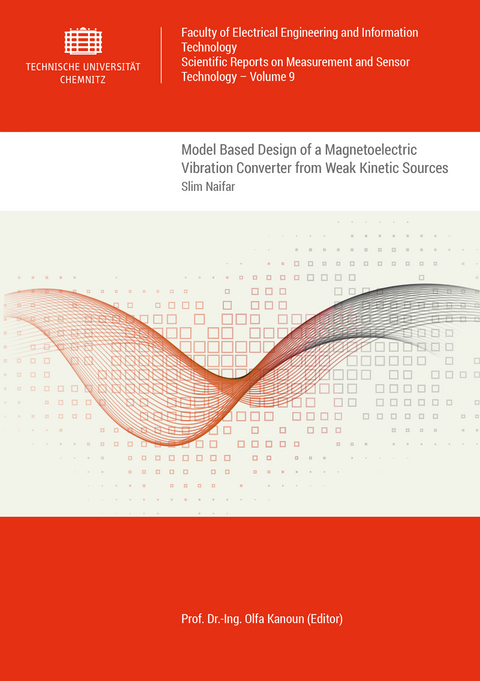
Model Based Design of a Magnetoelectric Vibration Converter from Weak Kinetic Sources
Seiten
2019
Universitätsverlag Chemnitz
978-3-96100-079-1 (ISBN)
Universitätsverlag Chemnitz
978-3-96100-079-1 (ISBN)
- Titel ist leider vergriffen;
keine Neuauflage - Artikel merken
The main challenge in the design of vibration energy harvesters is the optimization of energy outcome relative to the applied excitation to reach a higher efficiency in spite of the weakness of ambient energy sources. One promising principle of vibration converters is magnetoelectricity due to the outstanding properties of magnetostrictive and piezoelectric laminate composites, which provide interesting possibilities to harvest energy from low amplitude and low frequency vibration with relatively high energy outcome. For these devices, ensuring high deformations in the magnetostricive layers, improvement of the magnto-mechanical and the electro-mechanical couplings are highly required for the optimization of the energy outcome.This thesis primarily aims to develop a model based harvester design for magnetoelectric (ME) converters. Based on a comprehensive understanding of the complex energy flow in magnetoelectric transducers, several design parameters are investigated. For instance, magnetostriction in a Terfenol-D plate is investigated by means of atomic force microscopy under similar conditions as within magnetoelectric transducers. A novel measurement approach was successfully developed to detect the evolution of magnetic domains and measure deformations in a Terfenol-D plate in response to externally non-uniform applied magnetic fields.Furthermore, a finite element model is developed to predict the induced voltage in the ME transducer as a response to the magnet's displacement, corrected based on atomic force microscopy measurements, and used for the design of the harvester. The presented three- dimensional model takes into consideration the nonlinear behaviour of the magnetostrictive and piezoelectric materials. Additionally, three novel converters having different magnetic circuits are designed and analysed analytically based on Lindstedt-Poincaré method. The effects of the structure parameters, such as the nonlinear magnetic forces, the magnetic field distribution and the resonance frequency are discussed, and the electric output performances of the three designed converters are evaluated.In order to improve both mechanical and electrical coupling between the piezoelectric and the magnetostrictive layers, a bonding technique at room temperature is proposed which uses conductive polymer nanocomposites. Two magnetoelectric transducers are fabricated based on this technique having 1 wt.% and 2 wt.% concentration of multiwalled carbon nanotubes in epoxy resin. Another magnetoelectric transducer is fabricated by a classical technique for comparison purposes.In order to validate the design, a series of demonstrators are designed and fabricated according to the simulation and optimization results. The proposed design is composed by a cantilever beam, a magnetic circuit with several magnet arrangements and a magnetoelectric transducer, which is formed by a piezoelectric PMNT plate bonded to two magnetostrictive Terfenol-D layers. In this design, external vibrations are converted to magnetic field changes acting on the magnetostrictive layers leading to deformations, which are transmitted directly to the piezoelectric layer.The converters are tested under harmonic excitations and real vibration profiles reproduced by an artificial vibration source. Different parameters were investigated experimentally including the magnetic forces between the transducer and the magnetic circuit and the used bonding technique. Tuning the resonance frequency of the ME converter is also addressed using a simple screw/nut system, which allows to control the relative position and therefore the magnetic forces between the magnetic circuit and the transducer.The magnetoelectric transducer bonded with 2 wt.% concentration of multiwalled carbon nanotubes shows better output performances than the two other ME transducers under similar excitations. A maximum power output of 2.42 mW is reached under 1 mm applied vibration at 40 Hz.
| Erscheinungsdatum | 05.03.2019 |
|---|---|
| Reihe/Serie | Scientific Reports on Measurement and Sensor Technology ; 9 |
| Zusatzinfo | Illustrationen |
| Verlagsort | Chemnitz |
| Sprache | englisch |
| Maße | 148 x 210 mm |
| Themenwelt | Technik ► Elektrotechnik / Energietechnik |
| Schlagworte | Energieerzeugung • Energiegewinnung • Laminat-Verbundwerkstoffe • Magnetoelektrischer Effekt • Magnetostriktion • piezoelektrischer Effekt • Piezoelektrizität |
| ISBN-10 | 3-96100-079-4 / 3961000794 |
| ISBN-13 | 978-3-96100-079-1 / 9783961000791 |
| Zustand | Neuware |
| Haben Sie eine Frage zum Produkt? |
Mehr entdecken
aus dem Bereich
aus dem Bereich
Kolbenmaschinen - Strömungsmaschinen - Kraftwerke
Buch | Hardcover (2023)
Hanser (Verlag)
49,99 €


